Sorry, but your login has failed. Please recheck your login information and resubmit. If your subscription has expired, renew here.
November 2022
Are you resilient? It’s not an idle question. If there’s one word that I’ve heard at every supply chain event I’ve attended this year, its resilience. It is, of course, in response to the last few years in supply chain management. I think its fair to say that supply chains have been knocked to the canvas more times than Rocky. What has become clear as we do our post-pandemic reviews is that the firms that demonstrated the ability to get up off the canvas and keep punching were those that invested in resiliency before the pandemic—even if they didn’t use that term. Browse this issue archive.Need Help? Contact customer service 847-559-7581 More options
Are you resilient? It’s not an idle question. If there’s one word that I’ve heard at every supply chain event I’ve attended this year, its resilience. It is, of course, in response to the last few years in supply chain management. I think its fair to say that supply chains have been knocked to the canvas more times than Rocky. What has become clear as we do our post-pandemic reviews is that the firms that demonstrated the ability to get up off the canvas and keep punching were those that invested in resiliency before the
pandemic—even if they didn’t use that term.
For example, I recently visited with Medline’s supply chain team at their new 1.5 million state of-the-art distribution center. One of the things I found most interesting was that the team touted the $500 million investment they had made in added inventory to ensure that they can service their healthcare customers. They’re now carrying around $4 billion in stock across the network. When it looked like we were on the brink of a rail strike, Medline was able to assure is healthcare customers that the inventory they need to care for patients was already on the warehouse shelves.
What’s also clear is that resilience doesn’t just happen. It’s an investment in people, process and technology, and a best practice that has to be exercised in order to be ready when the next disruption—whatever that might be—happens. For instance, Len DeCandia, J&J’s CPO, recently told me that we have all invested heavily in customer relationship management to the detriment of supplier relationship management.

This complete article is available to subscribers only.
Log in now for full access or start your PLUS+ subscription for instant access.
SC
MR
Sorry, but your login has failed. Please recheck your login information and resubmit. If your subscription has expired, renew here.
November 2022
Are you resilient? It’s not an idle question. If there’s one word that I’ve heard at every supply chain event I’ve attended this year, its resilience. It is, of course, in response to the last few years in… Browse this issue archive. Access your online digital edition. Download a PDF file of the November 2022 issue.Are you resilient? It’s not an idle question. If there’s one word that I’ve heard at every supply chain event I’ve attended this year, its resilience. It is, of course, in response to the last few years in supply chain management. I think its fair to say that supply chains have been knocked to the canvas more times than Rocky. What has become clear as we do our post-pandemic reviews is that the firms that demonstrated the ability to get up off the canvas and keep punching were those that invested in resiliency before the
pandemic—even if they didn’t use that term.
For example, I recently visited with Medline’s supply chain team at their new 1.5 million state of-the-art distribution center. One of the things I found most interesting was that the team touted the $500 million investment they had made in added inventory to ensure that they can service their healthcare customers. They’re now carrying around $4 billion in stock across the network. When it looked like we were on the brink of a rail strike, Medline was able to assure is healthcare customers that the inventory they need to care for patients was already on the warehouse shelves.
What’s also clear is that resilience doesn’t just happen. It’s an investment in people, process and technology, and a best practice that has to be exercised in order to be ready when the next disruption—whatever that might be—happens. For instance, Len DeCandia, J&J’s CPO, recently told me that we have all invested heavily in customer relationship management to the detriment of supplier relationship management.
 SUBSCRIBERS: Click here to download PDF of the full article.
SUBSCRIBERS: Click here to download PDF of the full article.
SC
MR


Latest Supply Chain News
- Three frameworks for creative problem-solving in supply chain
- Mitigating geopolitical uncertainty: 4 essential tactics for industrial CSCOs
- Supply chain strategy for medical devices: A Q&A with industry expert Sanjay Gupta
- Inventory Management and the Supply Chain: Outlook 2025
- How technological innovation is paving the way for a carbon-free future in logistics and supply chains
- More News
Latest Podcast

 Explore
Explore
Business Management News
- Three frameworks for creative problem-solving in supply chain
- Mitigating geopolitical uncertainty: 4 essential tactics for industrial CSCOs
- Supply chain strategy for medical devices: A Q&A with industry expert Sanjay Gupta
- How technological innovation is paving the way for a carbon-free future in logistics and supply chains
- Parcel shipping spend: The untamed holdout in today’s supply chains
- Körber Supply Chain Software’s Craig Moore says MercuryGate acquisition is about the customer
- More Business Management
Latest Business Management Resources

Subscribe

Supply Chain Management Review delivers the best industry content.

Editors’ Picks





